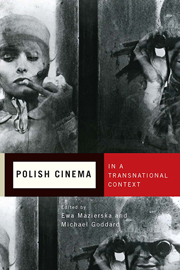Book contents
- Frontmatter
- Contents
- Acknowledgments
- Introduction: Polish Cinema beyond Polish Borders
- Part One The International Reception of Polish Films
- 1 West of the East: Polish and Eastern European Film in the United Kingdom
- 2 The Shifting British Reception of Wajda's Work from Man of Marble to Katyñ
- 3 Affluent Viewers as Global Provincials: The American Reception of Polish Cinema
- 4 Polish Films at the Venice and Cannes Film Festivals: The 1940s, 1950s, and 1960s
- 5 How Polish Is Polish?: Silver City and the National Identity of Documentary Film
- Part Two Polish International Coproductions and Presence in Foreign Films
- Part Three Émigré and Subversive Polish Directors
- Selected Bibliography
- List of Contributors
- Index
3 - Affluent Viewers as Global Provincials: The American Reception of Polish Cinema
from Part One - The International Reception of Polish Films
Published online by Cambridge University Press: 05 April 2014
- Frontmatter
- Contents
- Acknowledgments
- Introduction: Polish Cinema beyond Polish Borders
- Part One The International Reception of Polish Films
- 1 West of the East: Polish and Eastern European Film in the United Kingdom
- 2 The Shifting British Reception of Wajda's Work from Man of Marble to Katyñ
- 3 Affluent Viewers as Global Provincials: The American Reception of Polish Cinema
- 4 Polish Films at the Venice and Cannes Film Festivals: The 1940s, 1950s, and 1960s
- 5 How Polish Is Polish?: Silver City and the National Identity of Documentary Film
- Part Two Polish International Coproductions and Presence in Foreign Films
- Part Three Émigré and Subversive Polish Directors
- Selected Bibliography
- List of Contributors
- Index
Summary
“Film-making is the same all over the world.”
—Krzysztof Kieślowski“Don't worry about what the American critics are writing on your cinema … You and I, we are the best directors in the world!”
—Jean-Luc Godard to Jerzy Skolimowski“I understood some time ago that nobody in the West thinks or cares about Poland.”
—Krzysztof KieślowskiDilemmas of Definition and “Belonging”
It is a truism of film criticism that political and financial considerations affect the reception of any national cinema abroad. Accordingly, whatever interest people in the United States evinced in Soviet and Eastern European films during the Cold War era—prompted chiefly by the desire to gauge the fluctuating attitudes toward the West of “the other superpower” and the Soviet-controlled Eastern bloc—evaporated after the demise of the Soviet Union. For Americans, the fascination and challenge of the Soviet empire died upon the latter's disintegration into a mélange of disparate, embattled states and its satellites' consequent independence. Indeed, America's subsequent triumphalism rested on its self-identity as the politically validated, unassailable citadel of democracy and the sole remaining superpower in the world. That perceived superiority shaped its responses to European and perhaps especially Slavic culture, including film, even as the post-1989 financial chaos that wracked Russia and Eastern Europe threatened the very survival of their national film industries. Today, while contemporary public discourse indefatigably trumpets globalization, cinema audiences in the United States, with the exception of a minuscule minority, demonstrate an unambiguous preference for Hollywood fare and an indifference to films from Europe—a fortiori from the ideologically dispossessed Slavic world.
- Type
- Chapter
- Information
- Polish Cinema in a Transnational Context , pp. 56 - 76Publisher: Boydell & BrewerPrint publication year: 2014

